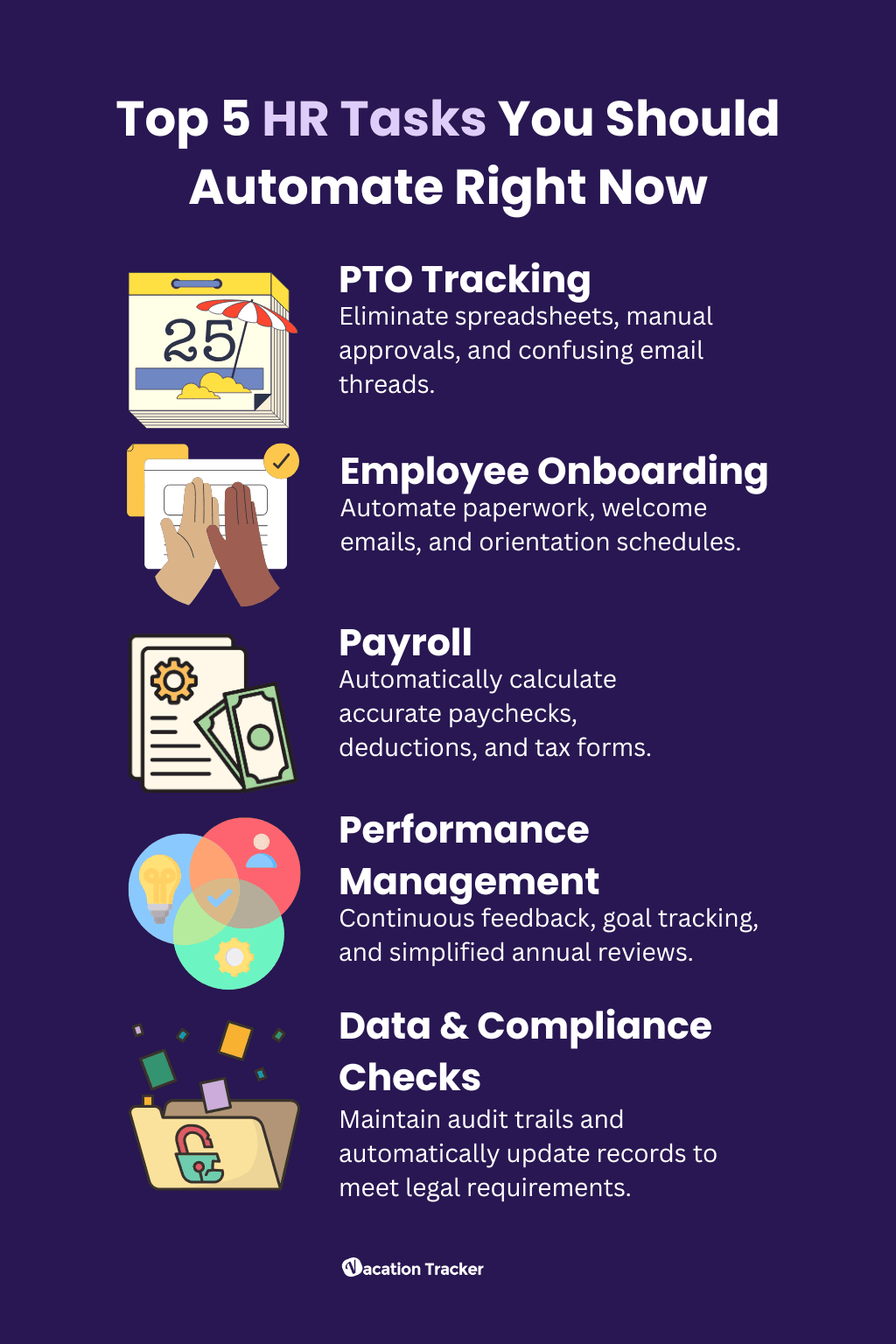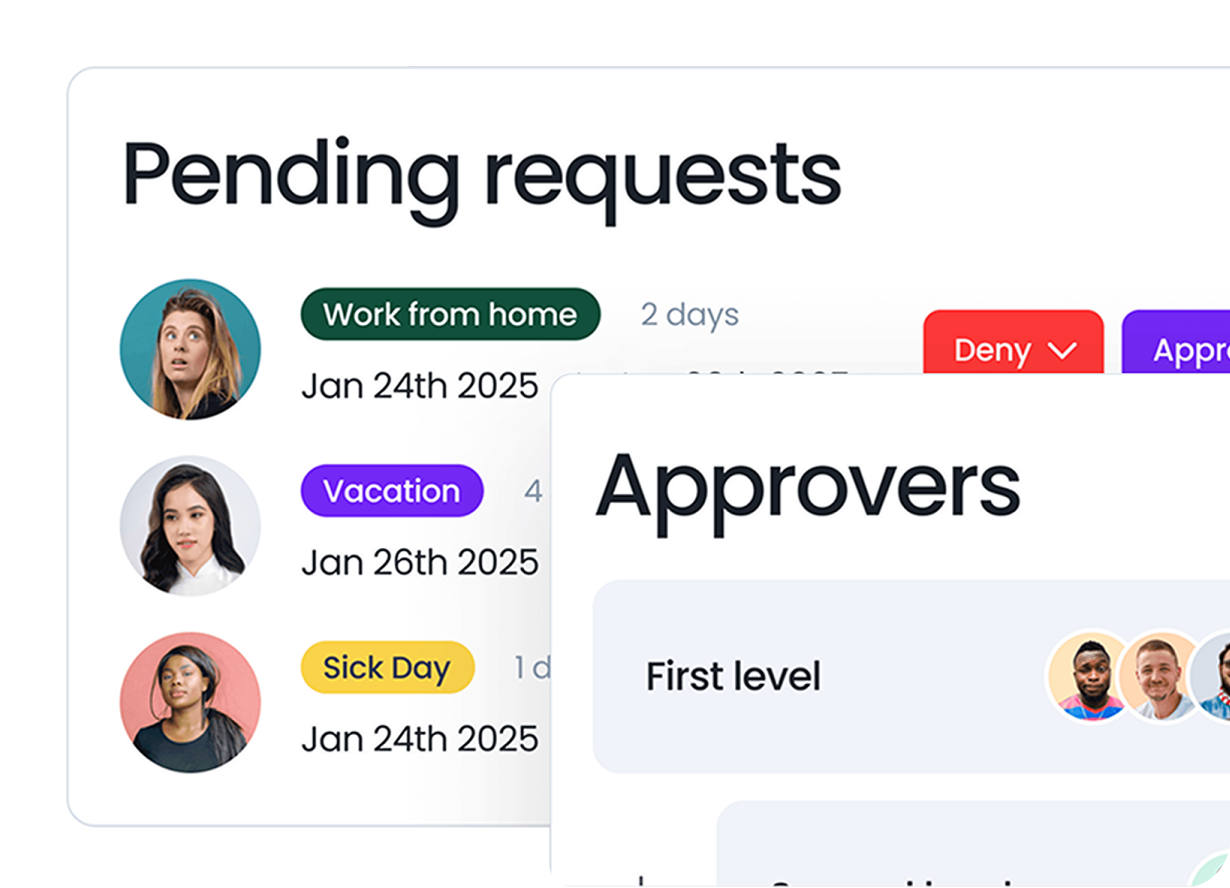Last updated on April 14, 2025
Picture this: You’re an HR manager at a growing business, trying to manage onboarding paperwork, vacation requests, payroll spreadsheets, and a hundred employee questions a minute.
Sound familiar?
It can often feel like there aren’t enough hours in the day. But what if some of those tasks could take care of themselves? That’s where HR technology comes in.
In this article, we’ll explore how using the right tech can boost your HR team’s efficiency and even make your employees happier. We’ll cover what HR tech actually is, how it saves you time, which HR tasks you can automate (spoiler: there’s probably more than you think), and common challenges. Let’s dive in!
What is HR technology?
Let’s start with the basics: HR technology is an umbrella term for any software, hardware, or tools all with a common goal: Make HR work easier and more productive.
Who’s it for, you ask? Well, HR tech isn’t just for big enterprises. In recent years, more and more small and mid-sized businesses have jumped on the bandwagon with about 80% of businesses now using some sort of HR software. If you’re still doing everything by hand or in Excel, you’re definitely not alone, but you might be working a lot harder and slower than you need to.
How HR Technology Boosts Efficiency
Alright, so we know what HR technology is. Now let’s get to the fun part: how can it actually make your work life easier? Let’s break that down a bit.
Automation of routine tasks
One of the biggest wins with HR tech is automating those repetitive, mundane tasks. HR systems can handle things like leave requests, scheduling, and data entry, so you don’t have to. By letting software take over the busy work, your team can focus on more meaningful projects that a computer can’t do, like strategy and development.
Did you know? HRs spend up to 57% of their time on administrative tasks that could be automated. Imagine reclaiming even half of that time!
Increased accuracy and fewer errors
We’re all human, and humans make mistakes, especially when tired or just managing too much. Unfortunately, mistakes in HR, like payroll errors or lost PTO forms, can be costly. Technology significantly cuts down on those errors. For example, when a system automatically calculates each employee’s paycheck, it’s inevitably going to be way more consistent than doing it by hand.
Enhanced compliance and transparency
HR deals with a lot of laws and regulations, including labor laws, tax rules, you name it. Staying compliant can be a headache if you’re doing it manually. The great thing about many HR systems is that they have compliance checks built in. They’re also great for keeping records. For instance, leave management software keeps detailed, accurate logs of everything, so if you ever get audited, you can pull records in minutes.
Better employee experience
Here’s a surprising benefit: efficient HR tech doesn’t just help HR, it makes employees happier too. Think about it. Employees today are used to doing nearly everything on their phones and computers from ordering an uber to paying rent and investing money, and they expect the same convenience at work. HR technology meets that expectation by providing self-service and quick responses.
Need to check your last pay stub or update your address? Just log into the HR portal. Want to request vacation? Submit it in the app and get a speedy approval notification.
Employees spend less time waiting for HR to process things and more time focusing on their actual jobs, making them more engaged and productive and less likely to quit. So, by improving the user experience of HR processes for your staff, you’re not only making them happier, but your business is also benefiting. It’s a win-win.
Key HR Processes Automated by Technology

PTO Management
Managing PTO might seem simple at first... until you’re the one doing it. Then you know it can turn into a mess of emails, spreadsheets, and sticky notes on your monitor with chaotic reminders like “Don’t forget Bob is off next Friday!”. Without the right system, tracking who’s on vacation and who has how many days left becomes a time-consuming, error-prone task.
This is where a dedicated leave management system comes in.
Vacation Tracker is a PTO tracking tool that integrates seamlessly with software you already use, like Slack and Microsoft Teams. This means that your employees can request time off at the click of a button, and managers get an instant notification to approve or deny, no separate logins or clunky forms needed.
Tracking Can Be
Learn how to manage time off without
confusion, delays, or admin headaches.

The system keeps track of everyone’s PTO balances and time off schedules. Imagine opening up a simple dashboard and seeing who has time off next week, rather than digging through emails. Team members also get reminded about upcoming holidays or if someone on their team is out, promoting transparency and planning.
For instance, when Alice submits a leave request, her manager clicks approve, and Alice plus the HR team gets a confirmation. Alice’s remaining days are automatically adjusted. The team calendar is updated so everybody knows she’ll be out, avoiding those “Where’s Alice today?” questions. When payroll time comes, HR or finance can pull a report of all PTO to ensure payouts or accruals are correct.
One more perk: compliance. Different places have different leave laws. Vacation Tracker helps ensure you’re compliant with those local requirements by allowing you to configure rules for each location.
Automating PTO management turns a potential logistical nightmare into a smooth, transparent process. Your HR team won’t miss replying to a never-ending list of questions about PTO balances, and employees definitely won’t miss waiting weeks to hear if they can take a few days off. As a result, people actually use their vacation time, which is great for preventing burnout, and the business runs more predictably because time off is well organized.
Employee Onboarding
There’s nothing quite like the excitement of a new hire’s first day but this can also be quite hectic for HR if you’re doing onboarding the ol' fashioned way. Onboarding involves a lot of moving parts from loads of paperwork to orientation schedules and setting up IT accounts.
HR technology brings order and consistency to onboarding, with standardized workflows that kick in as soon as someone signs their offer letter. For example, the moment a new hire is entered into the system, it can automatically send them a welcome email with links to fill out required forms online, even before their first day. Every new hire goes through the same well-structured process, which means no important steps are missed.
Payroll
💸 Payday is a happy day.... unless something goes wrong.
Payroll needs to be done correctly, 100% of the time. But, doing payroll manually can often lead to mistakes, like wrong amounts or missed paychecks.
Modern payroll software handles the heavy lifting of calculating each employee’s earnings, taxes, and deductions in accordance with federal, provincial, and state laws. The system can also generate all the documents you need automatically, including pay stubs and tax forms like W-2s or T4S, with just a few clicks. Once you’ve input initial setup info, like salaries or hourly rates, running payroll can be as easy as clicking “Process Payroll” and letting the system crunch numbers.
Performance Management
Performance management has traditionally been associated with dreaded annual review meetings and piles of paperwork that managers and HR struggle to complete. It’s often tedious for everyone involved, employees, managers, and HR alike. But it doesn’t have to be. Technology is changing performance management from a once-a-year formality into a continuous, helpful process.
Modern performance management software allows you to set goals, provide ongoing feedback, and conduct reviews in a much more dynamic way. Employees can input their own updates or accomplishments as they go. Come review time, you’re not starting from scratch, all those notes and feedback through the year are compiled, which makes evaluations more comprehensive.
Data & Analytics
Strategic, data-driven decisions are essential for successful HR and analytics is at the heart of that. Workforce analytics is all about using data to gain insights into your staff and using it to make better decisions. Modern HR tools are making analytics accessible and incredibly useful for even HR teams of all sizes.
The data could be anything from promotion rates and turnover rates to employee engagement scores and absenteeism. For HR managers not used to analytics, adopting these tools can be eye-opening. You start spotting things you weren’t aware of and implement some real change.
Common HR Technology Challenges
Even with the best plan, adopting new HR technology can come with some bumps in the road. That’s normal. Change is hard, and no software is perfect. The good news is that knowing these challenges in advance means you can address them proactively. Let’s talk about a few common hurdles HR managers face when implementing new tech and how to tackle each.
Integration issues
You want to get a new system, but first, you need to see if it plays nicely with your current tech stack. When your tools don’t talk to each other, this can often result in double data entry, lost time, errors, and confusion.
To overcome this, plan for integration from the start. Choose software that has open APIs or pre-built integrations. Even simple integration, like ensuring your new leave tracker updates Google Calendar or Outlook automatically, can save headaches and prevent miscommunications.
Collaboration with your IT team is key here. They can assist in making two systems talk to each other securely. And if something truly can’t integrate, have a clear process for how data will be shared or entered to minimize errors.
Data security and privacy
HR data is some of the most sensitive data there is: personal info, salaries, performance notes, and maybe even medical records. When you move that data into the cloud or a new system, it’s normal to worry: Is it safe?
Additionally, privacy regulations like GDPR mean you have to handle data carefully. To overcome these concerns, do your due diligence on any tech vendor: ensure they use strong encryption, have robust security certifications, and can articulate their privacy protections.
Internally, work with IT to implement best practices like using single sign-on, strong passwords, 2-factor authentication, and strictly define user roles in the system.
User adoption and training
You might love the new system, but what if employees or managers just don’t use it? User adoption is essential; a fantastic tool is worthless if people refuse to get on board. Resistance to change is natural but overcome this by investing in training as much as the tool itself.
Show employees how the change benefits them personally, like faster answers, less hassle. Encourage managers to lead by example. If they enthusiastically use the new system, their teams will follow. Over time, using the new tech will become second nature. And if you continue to collect feedback, you can adjust things to improve the user experience, which further drives adoption.
Ready to use technology for HR efficiency?
We’ve explored HR technology, from what it is, to how it can improve productivity in daily tasks, to specific HR processes it transforms, plus a roadmap for overcoming common challenges.
Using technology for HR efficiency isn’t a trend, it’s about working smarter, not harder, and maybe reducing a bit of that daily HR stress we all know too well.
If you’re ready to turn PTO management into one less thing to worry about, give Vacation Tracker a try. With effortless leave requests, instant approvals, and seamless integration into tools your team already uses, you’ll reclaim hours in your week and create a happier, more organized workplace.

Claudia
Claudia is an experienced marketer with a passion for writing and creating engaging content that connects with readers.




